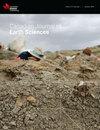Lead isotopes in New England (USA) volcanogenic massive sulphide deposits: implications for metal sources and pre-accretionary tectonostratigraphic terranes
IF 1.6
4区 地球科学
Q3 GEOSCIENCES, MULTIDISCIPLINARY
引用次数: 0
Abstract
Lead isotope values for volcanogenic massive sulphide (VMS) deposits provide important insights into metal sources and the nature of pre-accretionary tectonostratigraphic terranes and underlying basements. Deposits of this type in New England formed in diverse tectonic settings including volcanic arcs and backarcs, a supra-subduction zone arc, a rifted fore-arc foreland basin, and a rifted continental margin. Following VMS mineralization on or near the seafloor, components of the tectonostratigraphic assemblages—volcanic ± sedimentary rocks, coeval intrusions, sulphide deposits, and underlying basements—were diachronously accreted to the Laurentian margin during the Paleozoic. Lead isotope data for galena show relatively large ranges for 206Pb/204Pb, 207Pb/204Pb, and 208Pb/204Pb. Evaluation of potential lead sources, using for comparison Pb-isotope data from modern and ancient settings, suggests that principal sources include the mantle, volcanic ± sedimentary rocks, and deeper basement rocks. Integration of the Pb-isotope values with published data such as Nd isotopes for the volcanic rocks and from deep seismic reflection profiles points to the involvement of several basements including those of Grenvillian, Ganderian, Avalonian, and West African (and/or Amazonian) affinity. Clustering of Pb-isotope data for VMS deposits within individual Cambrian and Ordovician volcanic and volcanosedimentary settings, delineated by differences in 206Pb/204Pb and µ (238U/204Pb) values, are consistent with lead derivation from at least four and possibly five different tectonostratigraphic assemblages with isotopically distinct basements. Collectively, our Pb-isotope data for New England VMS deposits provide a novel window into the nature of sub-arc basement rocks during pre-accretionary sulphide mineralization outboard of Laurentia during early Paleozoic time.新英格兰(美国)火山成因块状硫化物矿床中的铅同位素:对金属来源和成矿前构造地层的影响
火山成因块状硫化物(VMS)矿床的铅同位素值为了解金属来源以及成矿前构造地层和下伏基底的性质提供了重要信息。新英格兰地区的此类矿床形成于不同的构造环境中,包括火山弧和背弧、超俯冲带弧、断裂前弧前陆盆地和断裂大陆边缘。在海底或海底附近的VMS矿化之后,构造地层组合的组成部分--火山岩和沉积岩、共生侵入体、硫化物矿床以及下伏基底--在古生代期间异时增生到劳伦大陆边缘。方铅矿的铅同位素数据显示,206Pb/204Pb、207Pb/204Pb 和 208Pb/204Pb 的范围相对较大。通过比较现代和古代环境中的铅同位素数据,对潜在铅源的评估表明,主要铅源包括地幔、火山和沉积岩以及较深的基底岩石。将铅同位素值与已公布的数据(如火山岩和深层地震反射剖面的钕同位素)进行整合,表明涉及多个基底,包括与格伦维里亚、甘德尔、阿瓦隆和西非(和/或亚马逊)有亲缘关系的基底。根据 206Pb/204Pb 和 µ (238U/204Pb)值的差异划分的寒武纪和奥陶纪火山和火山沉积环境中 VMS 沉积物的铅同位素数据群,与铅至少来源于四种(可能是五种)不同的构造地层组合以及同位素上不同的基底相一致。总之,我们为新英格兰 VMS 矿床提供的铅同位素数据为了解古生代早期劳伦西亚外侧前成矿硫化物矿化过程中弧下基底岩石的性质提供了一个新的窗口。
本文章由计算机程序翻译,如有差异,请以英文原文为准。
求助全文
约1分钟内获得全文
求助全文
来源期刊

Canadian Journal of Earth Sciences
地学-地球科学综合
CiteScore
2.80
自引率
7.10%
发文量
66
审稿时长
6-12 weeks
期刊介绍:
The Canadian Journal of Earth Sciences reports current research in climate and environmental geoscience; geoarchaeology and forensic geoscience; geochronology and geochemistry; geophysics; GIS and geomatics; hydrology; mineralogy and petrology; mining and engineering geology; ore deposits and economic geology; paleontology, petroleum geology and basin analysis; physical geography and Quaternary geoscience; planetary geoscience; sedimentology and stratigraphy; soil sciences; and structural geology and tectonics. It also publishes special issues that focus on information and studies about a particular segment of earth sciences.
 求助内容:
求助内容: 应助结果提醒方式:
应助结果提醒方式:


